
The Atlantic horse mackerel, also known as the European horse mackerel or common scad, is a species of jack mackerel in the family Carangidae, which includes the jacks, pompanos and trevallies. It is found in the eastern Atlantic Ocean off Europe and Africa and into the south-eastern Indian Ocean. It is an important species in commercial fisheries and is listed as a Vulnerable species on The IUCN Red List of Threatened Species.

The butterfly kingfish is an ocean-dwelling ray-finned bony fish in the mackerel family, Scombridae – a family which it shares with the tunas, mackerels, Spanish mackerels, and bonitos. It, however, represents a lineage distinct from all other scombrids and has therefore been placed in its own genus Gasterochisma and subfamily Gasterochismatinae.

The Gempylidae are a family of perciform fishes commonly known as snake mackerels or escolars. The family includes about 25 species.
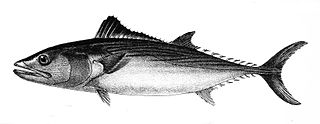
Sarda chiliensis, the eastern Pacific bonito, is a marine species of bonito. It ranges from Ecuador to Chile. Sarda lineolata, which ranges from Alaska to Mexico was formerly considered a subspecies, as Sarda chiliensis lineolata, but this treatment renders the species geographically disjunct.
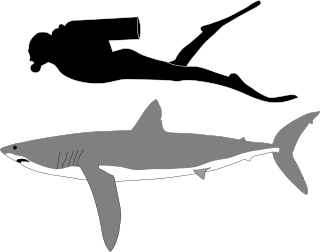
The longfin mako shark is a species of mackerel shark in the family Lamnidae, with a probable worldwide distribution in temperate and tropical waters. An uncommon species, it is typically lumped together under the name "mako" with its better-known relative, the shortfin mako shark. The longfin mako is a pelagic species found in moderately deep water, having been reported to a depth of 220 m (720 ft). Growing to a maximum length of 4.3 m (14 ft), the slimmer build and long, broad pectoral fins of this shark suggest that it is a slower and less active swimmer than the shortfin mako.

The crocodile shark is a species of mackerel shark and the only extant member of the family Pseudocarchariidae. A specialized inhabitant of the mesopelagic zone, the crocodile shark can be found worldwide in tropical waters from the surface to a depth of 590 m (1,940 ft). It performs a diel vertical migration, staying below a depth of 200 m (660 ft) during the day and ascending into shallower water at night to feed. Typically measuring only 1 m (3.3 ft) in length, the crocodile shark is the smallest living mackerel shark. It can be distinguished by its elongated cigar-shaped body, extremely large eyes, and relatively small fins.

A piscivore is a carnivorous animal that primarily eats fish. The name piscivore is derived from Latin piscis 'fish' and vorō 'to devour'. Piscivore is equivalent to the Greek-derived word ichthyophage, both of which mean "fish eater". Fish were the diet of early tetrapod evolution ; insectivory came next; then in time, the more terrestrially adapted reptiles and synapsids evolved herbivory.
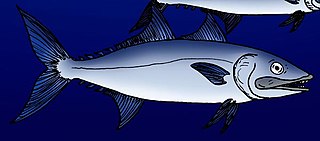
Zaphlegulus venturaensis is an extinct, superficially mackerel-like, fish related to the cutlassfish and snake mackerels found off the coast of what is now California during the late Miocene. Z. venturaensis was shorter, but stouter than either of the other two better known genera of the extinct family Zaphlegidae, Thyrsocles and Euzaphleges, which also lived at the same time.

Scomber is a genus of fish in the family Scombridae living in the open ocean found in Atlantic, Indian and Pacific Ocean. The genus Scomber and the genus Rastrelliger comprise the tribe Scombrini, known as the "true mackerels". These fishes have an elongated body, highly streamlined, muscular and agile. The eyes are large, the head is elongated, with a big mouth provided with teeth. They have two triangular dorsal fins, with some stabilizing fins along the caudal peduncle. The basic color is blue-green with a silvery white belly and a darker back, usually black mottled.
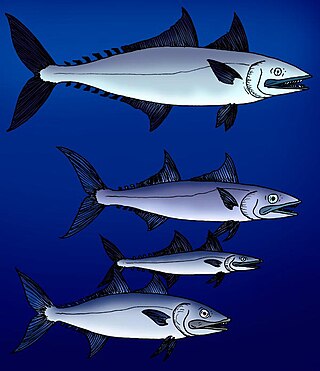
Euzaphlegidae is a family of extinct escolar-like fish closely related to the snake mackerels. Fossils of euzaphlegids are found from Paleocene to Late Miocene-aged marine strata of Europe, the Caucasus Mountains, India, Iran, Turkmenistan, Italy, and Southern California.
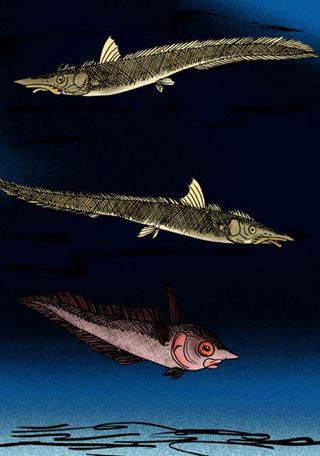
Laytonia is an extinct genus of prehistoric halosaur that lived in deep water off the North American Pacific Coast from the Zemorrian Epoch until during the Upper Miocene subepoch, when tectonic uplift effectively destroyed the genus' habitat by making the deep water too shallow.

Bolbocara is an extinct genus of rattail that lived during the Upper Miocene subepoch of Southern California. It contains a single species, B. gyrinus. It may be related to the extant genus Bathygadus.
Tunita is an extinct genus of prehistoric mackerel that lived during the Upper Miocene subepoch of Southern California.
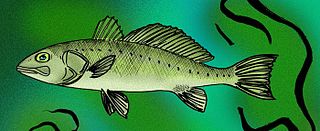
Lompoquia retropes is an extinct genus of ray-finned fishes belonging to the family Sciaenidae, the drums. These fishes lived what is now Southern California during the Upper Miocene subepoch.
Ioscion morgani is an extinct prehistoric bony fish that lived during the Upper Miocene subepoch of what is now Southern California. It is primarily known from incomplete fossils, such as the holotype, which consists of a broken backbone. Although the head is unknown, enough of the animal's anatomy suggests a relationship with the jackfishes of Carangidae.

Chalcidichthys is an extinct genus of prehistoric manefish. It contains a single species, C. malacapterygius, that lived during the Upper Miocene of Southern California. It is known from the Modelo Formation in Los Angeles County, and specimens were found during construction of a tunnel on Sepulveda Boulevard. It is assumed to have preyed on siphonophores, like its living relatives.
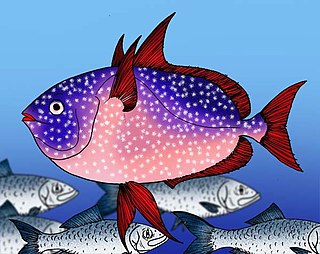
Lampris zatima is the oldest known opah of the genus Lampris, from the Late Miocene of Southern California. Its fossil record is rather poor, known primarily from isolated vertebral columns, and a few headless specimens. Alive, it is estimated to have been around 20 to 30 centimeters long.
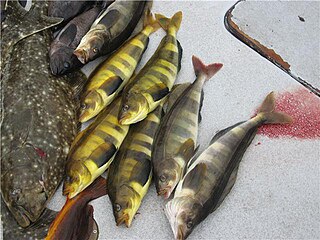
The Atka mackerel is a mackerel in the family Hexagrammidae. Atka mackerel are common in the northern Pacific Ocean, and are one of only two members of the genus Pleurogrammus - the other being the Arabesque greenling. The Atka mackerel was named for Atka Island, the largest island of the Andreanof islands, a branch of the Aleutians.

The Pacific sierra also known as the Mexican sierra, is a ray-finned bony fish in the family Scombridae, better known as the mackerel family. More specifically, this fish is a member of the tribe Scomberomorini, the Spanish mackerels. It occurs in the eastern Pacific Ocean from southern California to Antofagasta in Chile.
Araeosteus rothi is an extinct species of bony fish closely related to the modern-day prowfish, Zaprora silenus. A. rothi is found in Late Miocene marine strata of Southern California, primarily the Diatom Beds of Lompoc and the Santa Monica Mountains.

















